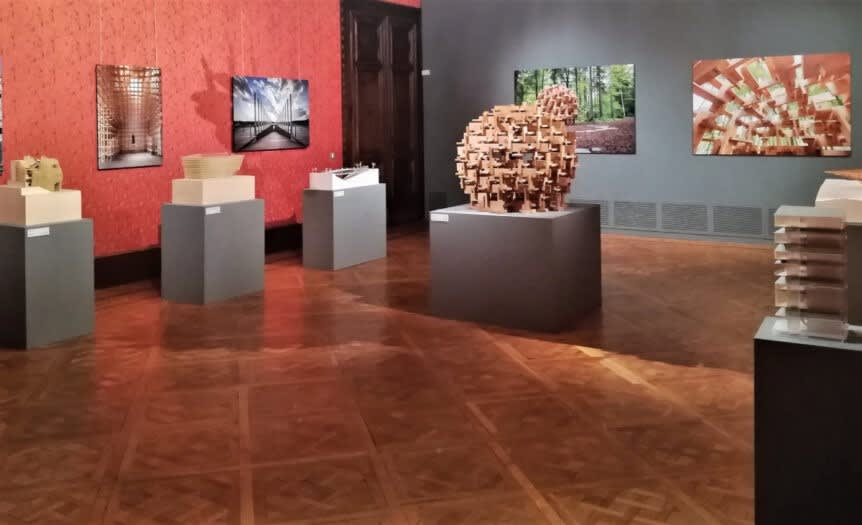
UNTIL 26 NOVEMBER, AN EXHIBITION AT PALAZZO FRANCHETTI TELLS ITS ARCHITECTURE THROUGH ONOMATOPOEIA
VENICE. Outside the official circuits of the Biennale, in the rooms of Palazzo Franchetti, a sort of characteristic call takes shape, expressed as a mantra in 13 words whose sound in the original language directly introduces the character of Kengo Kuma's projects (para para/full-empty , sara sara/fluid-soft, guru guru/fluid-tornado, vortex, suke suke/horizontal-flat, giza giza/hard-bend… and so on); a form, in its way, of simplification that the Japanese architect chose to involve the big public in the personal exhibition “Kengo Kuma. Onomatopoeia Architecture”.
According to Kuma, thanks to the onomatopoeias (taking up the book on the subject written in 2015) matter and the body speak and vibrate in unison, without needing anything else: «In this Venetian exhibition […] I would like to show to the public my way to establish a dialogue with the materials. I am particularly attracted by soft materials; softness always heals me because it reminds me of my mother."
INTIMATE AGGREGATIONS OF MATERIAL PARTS
Seeing is believing. Once inside the rooms the feeling is exactly the one of a facilitated view of each project presented (reproduced in real photos and in the beautiful models for a close-up 360° view), while you would want to touch everything with your hands, to feel the thin pleasure of a fluid line, the precise digression of voids (small and large), the many surprising textures of precious woods still smelling of the forest («Onomatopoeia does not treat architecture as the object of operations by agents superiors (architects), but places architecture and human beings on the same level. […] Onomatopoeia is like an animal voice, emitted on a physical and experiential level». Even more so since each project presents itself as a sum of parts that the careful eye of the viewer will be able to scan until reconstituting, step by step, its birth. No monumental form, therefore, but intimate aggregations of material parts, almost every time precious essences which, when added, interlocked, meticulously arranged, they give life to architecture, create spaces, invite us to stop, promise worlds in their apparent simplicity; because, indeed, upon closer inspection, the architect's creativity is confirmed in every smallest detail and often reaches the sublime.
This is the case of the Coeda House (Shizuoka, Japan, 2017), where the character of the place is spread in full horizontality (suke suke) and visual permeability but starting from an eccentric fulcrum in cedar wood which, like a stylized tree, pervades the ceiling, breaking the silence of the glass walls. Here the material contrast predominates and the dialogue between nature and artifice becomes intense. Until, in a crescendo of sensations, the pressure increases and the matter is literally exploded (tsun tsun) and projected into space, in a deflagration of constructive and compositional elements: we are in front of the GC Prostho Museum Research Center (Aichi, Japan, 2010 ) whose concrete structure is enveloped by a parametric decorative system made up of cypress wood elements that create regular prismatic combinations, obtained through interlocking joints. A show for the eyes.
Kuma is radical: «I grew up in a small wooden house and I think that the architects of my generation must find another material besides concrete. Concrete is the material of the industrial society of the 20th century […]. Wood is the most interesting material for replacing concrete." Therefore, the building of the community center The Darling Exchange (Sydney, Australia, 2019) is also wrapped in sticks of pine wood that unravel themselves in a spiral (guru guru) like a ball of wool, almost as if it was a huge nest ("I'm really impressed by birds' nests. They collect different materials and build their homes without too much trouble").
Going from wood to natural stone the matter does not change: Kuma directs it’s meaning depending on whether it is a question of bending its hardness (giza giza) as for La Galilée de Saint-Maurice d'Angers (France, 2020-), an elegant vestibule to protect the western portal of the Gothic cathedral of Angers, where precious polychrome sculptures from the 12th and 17th centuries were discovered; or to highlight its rough surface (zara zara) as in the Kadokawa Culture Museum (Tokorozawa, Japan, 2015-2020), a multifunctional complex whose main volume is conceived as an enormous rock with angular sides, thanks to a covering of Black Fantasy Granite whose gray and black surfaces are dotted with white spots (The architecture is formed exactly like a real rock… And when you enter the rock you will find a labyrinth-shaped library. In there you lose awareness of where you are).
A sequence of projects which are, in fact, like entrances into other worlds. «Literature and architecture are very similar. Both literature and architecture must provide dreams to the people. Architecture that only solves a specific program is not really necessary in our world", declares Kuma in the video present in the exhibition; the same thing happens in the novels of his favorite writer, Haruki Murakami, to whom the homonymous library project in Tokyo (2021) is also dedicated.
CREATING OTHER WORLDS
In 2016 Kuma received the Global Award for Sustainable Architecture. But what sustainability are we referring to? Certainly not the more debased and fashionable one that, like it or not, the media is accustoming us to. Kuma's work is sustainable because it gives a face to a design universe in danger of extinction where each piece, in its expressive frankness, acts as a counterbalance to our megalomaniac existence and in its small way dares to become once again pulsating, made of sensations that we risk to forget in a lot of background noise, and where nature (with particular reference to the used materials) is put to work thanks to the expert hand of the architect who manages to combine its character with the most advanced technologies towards forms of cultured mediation and visual stratagems that run on the edge of imagination and stubborness.
